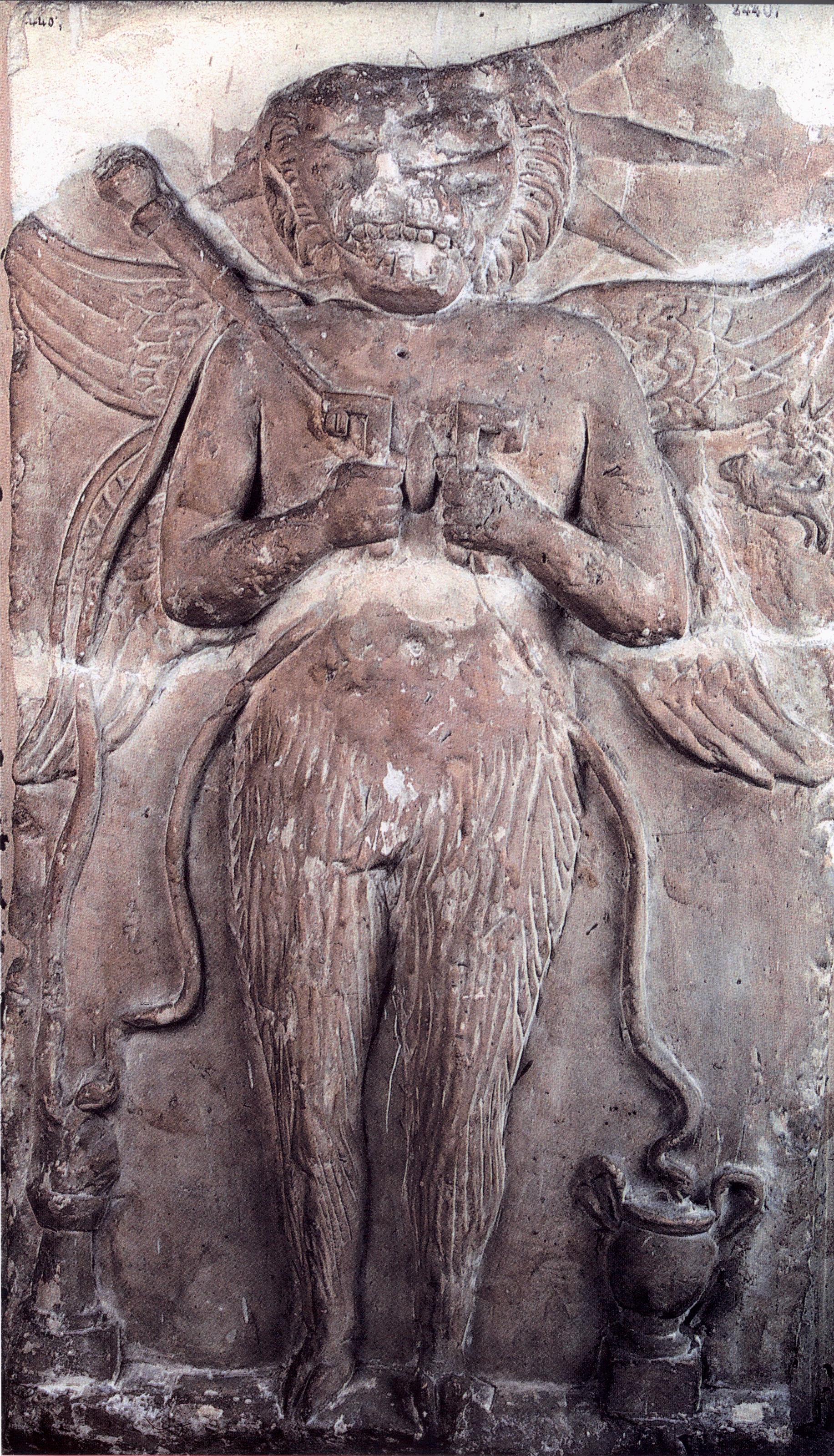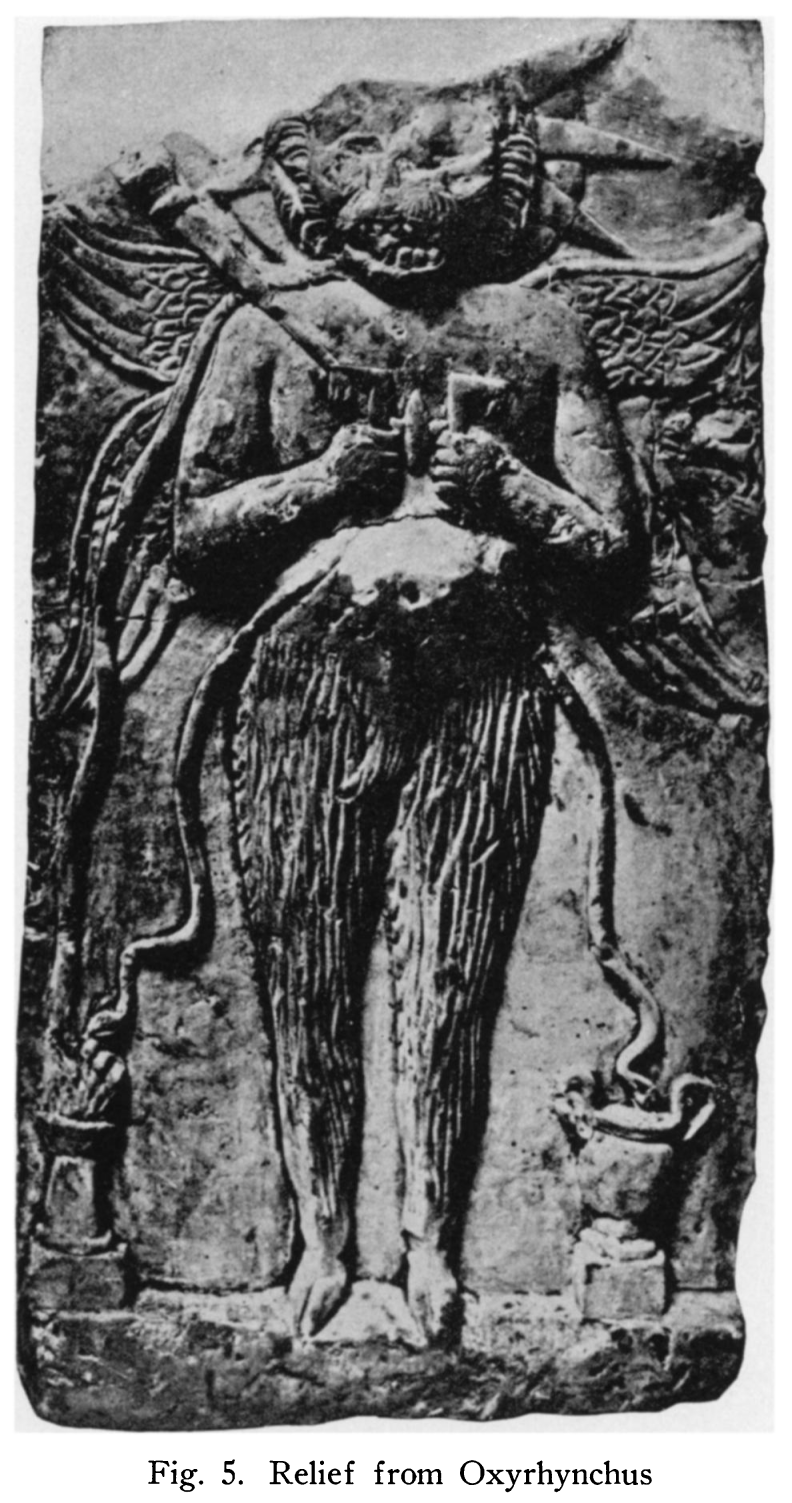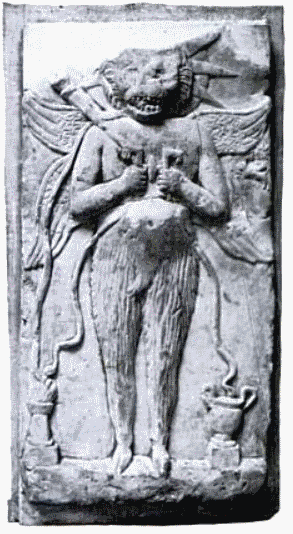
CIMRM 103 - Lion-headed god. Oxyrhynchus, Egypt.
CIMRM entry
OXYRHYNCHUS
103.
Relief in limestone (H. 0.98-1.02 Br. 0.57-0.58 D. 0.08) broken in three parts. "Un ritrovamento clandestino dei cavatori di Sebach". Museum of Greek and Roman Antiquities at Alexandria.
Breccia, Cronos mitriaco, 257ff with Pl. (see fig. 36) ;D. Levi in Hesperia XII, 1944, 275 fig. 5; Pettazzoni in AntC. XVIII, 1949, 271 and Pl. II, 4.
Standing Aion with four wings, one pair pointing upwards, the other pair pointing downwards. The god is represented as partly human partly animal. Around the lion's head a nimbus with radiate crown, only four of which are visible owing to damage. Bare arms and breast; the lower part of the body from the hips to the cloven hoofs is covered with shaggy hair. A rearing lion has been represented between the two left wings, above the animal a star. In each hand he holds a key, moreover, the r.h. lifts a torch; between his thumbs along object, probably a lightning.
From each hand a snake is hanging, one of which holds his head over a krater, the other over a small burning altar, which are standing on either side of the god. Creeping up to the altar is a third and bigger snake, coming from between the teeth of Aion' s mouth.
On the relief remnants of a coat of painting have been preserved (golden-yellow, red, blue).
According to Pettazzoni in AntC. XVIII, 1949, 265ff the Aion in general finds its iconographical origin in Egypt. In connection herewith it may be suitable to point out, that Mithras must have been worshipped in Egypt in the third century B.C. A papyrus from Gurob in the Fajoum (J. G. Smyly, Greek Papyri from Gurob (Cunningham Memoirs XII), Dublin 1921, 36ff) contains an inventary of small cattle belonging to the temple properties of Aphrodite, Hermes, Nephtimis and. according to line 10, of Mithras. Of this "Mithraeum", however, no traces have been found.
In a papyrus from Oxyrhynchus from 214 A.D. a certain M. Aurelius Andronicus has the surname of Mithres (U. Wilcken, Grundzüge der Papyruskunde, Berlin 1912, 129; W. Schubart, Einführung in die Papyruskunde, Berlin 1918,343; 353).
See also Raffaele Pettazoni, "The monstrous figure of time in Mithraism", Essays on the history of religion, Brill, 1967, p.184. This gives the photo (not on Google books) as from E. Breccia, "Melanges Maspero" II, Le Caire, 1934, = Memoires de l'Institut Francais d'Archeologie Orientale, LXVII.
| 1 | Doro Levi, "Aion", Hesperia: The Journal of the American School of Classical Studies at Athens 13 (1944), pp. 269-314. Online at JSTOR, 274-5: "In view of all this, a monstrous image, of which numerous monuments are preserved to us (Figs. 4 and 5), is generally considered nowadays to be a representation of Chronos and an expression of Orphic conceptions. It has usually a leonine head and a human body encircled by a serpent's coils, on its shoulders are four wings adorned with the symbols of the four seasons, and it holds two keys in its hands. We shall see, however, that not at all to be rejected is the old theory of Zoega according to which this would be the divine being called, in the sacred books of the mysteries, Aion...". |
| 2 | Alan K. Bowman, Egypt after the Pharaohs: 332 BC-AD 642 : from Alexander to the Arab Conquest, 1996, p.175. |
| Tweet |


